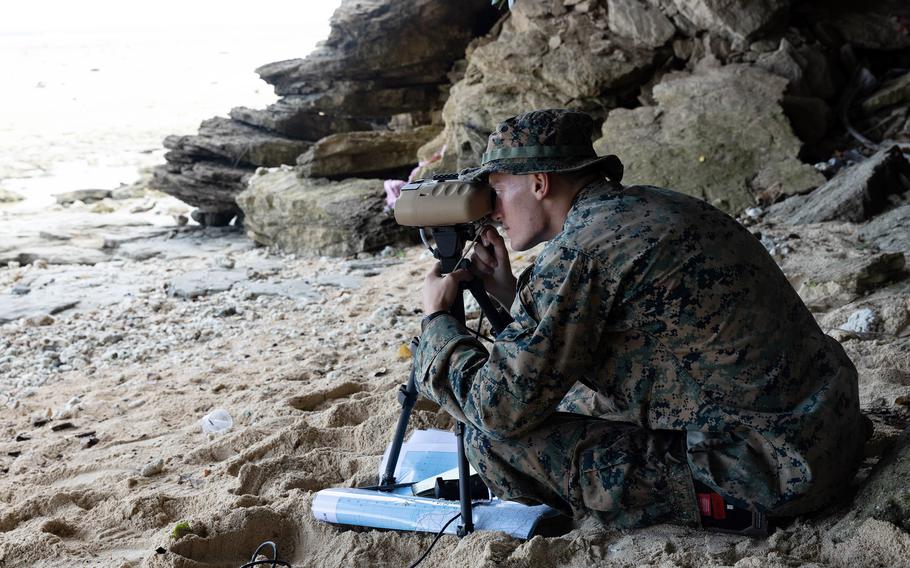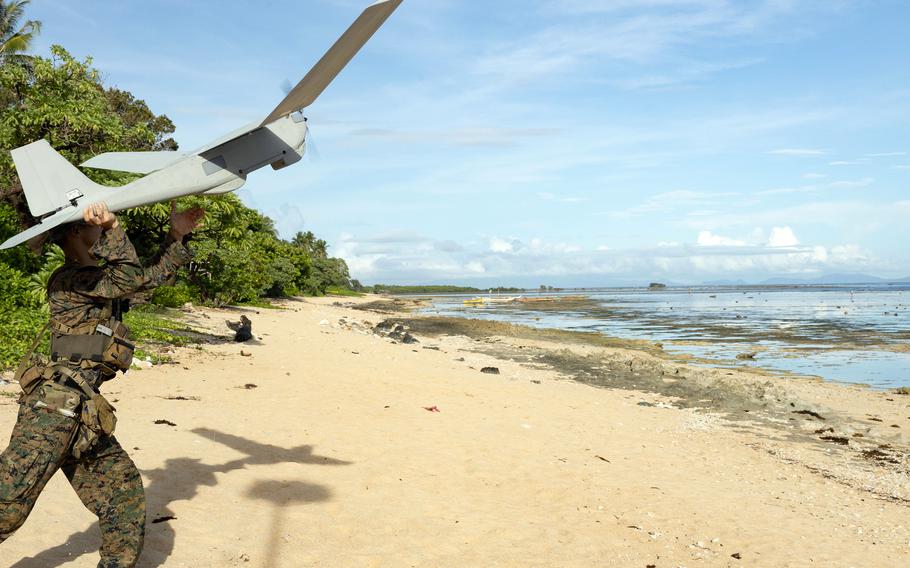
Cpl. Hunter Way, a fire support Marine with Marine Rotational Force -- Southeast Asia, watches for vessels during an exercise in Sorsogon, Philippines, Oct. 9, 2023. (Kai W. Huber/U.S. Marine Corps)
A relatively new Marine Corps rotational force has arrived in the Philippines for its third six-month deployment, just as the longtime U.S. ally engages in a test of wills with China.
Marine Rotational Force — Southeast Asia is scheduled to start work Monday with 2 ½ weeks of training alongside Philippine forces: Sama Sama and Kamandag, according to a news release Thursday from force spokesman Capt. Mark McDonough.
“The Marine Corps is committed to preserving the freedom of the region and its people,” rotational force commander Col. Stuart Glenn said in the release.
Representatives of the force did not respond to emailed questions about its mission Friday.
This year’s rotation begins as the 2,000-strong Marine Rotational Force — Darwin, formed in 2012, concludes a six-month deployment to Australia’s Northern Territory.
The arrival of Marines and sailors in the Philippines coincides with a series of clashes between the Philippine and Chinese coast guards over control of several shallow reefs close to the Philippines’ western shores.

Sgt. Vincent Tran, a maritime sensing chief with Marine Rotational Force -- Southeast Asia, launches an RQ-20 Puma drone during training in Sorsogon, Philippines, Oct. 9, 2023. (Kai W. Huber/U.S. Marine Corps)
Beijing lays claim to nearly the entire South China Sea, including maritime territory inside the Philippines’ exclusive economic zone.
The countries clashed in late August at Sabina Shoal, where Philippine authorities allege a Chinese coast guard ships rammed a Philippine vessel three times.
They also agreed to ease mounting tensions at Second Thomas Shoal, where Filipino marines man an outpost on a grounded, rusting warship.
In July, the commander of the Darwin rotational force said his unit was ready to back up Manila in clashes with Beijing over the shoal.
“We were given a warning order to support the Philippines’ defense forces in resupplying of the Second Thomas Shoal,” Col. Brian Mulvihill told Stars and Stripes on July 24.
Marine Rotational Force — Southeast Asia includes members of I Marine Expeditionary Force at Camp Pendleton, Calif.
The force will vary in size and composition during its mission, according to the news release.
Last year, Sama Sama — Tagalog for “together” — involved seven nations in anti-submarine, anti-surface, anti-air and electronic warfare practice off Luzon, the Philippines’ largest island.
Last year’s Kamandag involved 2,000 troops, mostly U.S. and Philippine marines, learning to fight alongside each other on Luzon and Palawan, about 87 miles east of Sabina Shoal and 121 miles from the Second Thomas Shoal.
The Southeast Asia rotation continues through March 2025 and also includes training with forces from Malaysia, Indonesia, Brunei, Singapore and Thailand, according to the release.
The force will train in several areas, including aircraft fires integration; combat medical care; logistics support in contested environments; small boat operations; and drone employment.
It will also do live-fire training, military operations in urban terrain and hand-to-hand combat, according to the release.
The rotation is a sign that I MEF is focused on the Indo-Pacific after years of involvement in conflicts in the Middle East and South Asia, said retired Marine Col. Grant Newsham, a senior researcher with the Japan Forum for Strategic Studies in Tokyo.
Marine Rotational Force — Southeast Asia “also serves a purpose in having Marines operating in the region outside of Darwin — especially in the wet months when training in Northern Australia is difficult,” he said by email Friday.